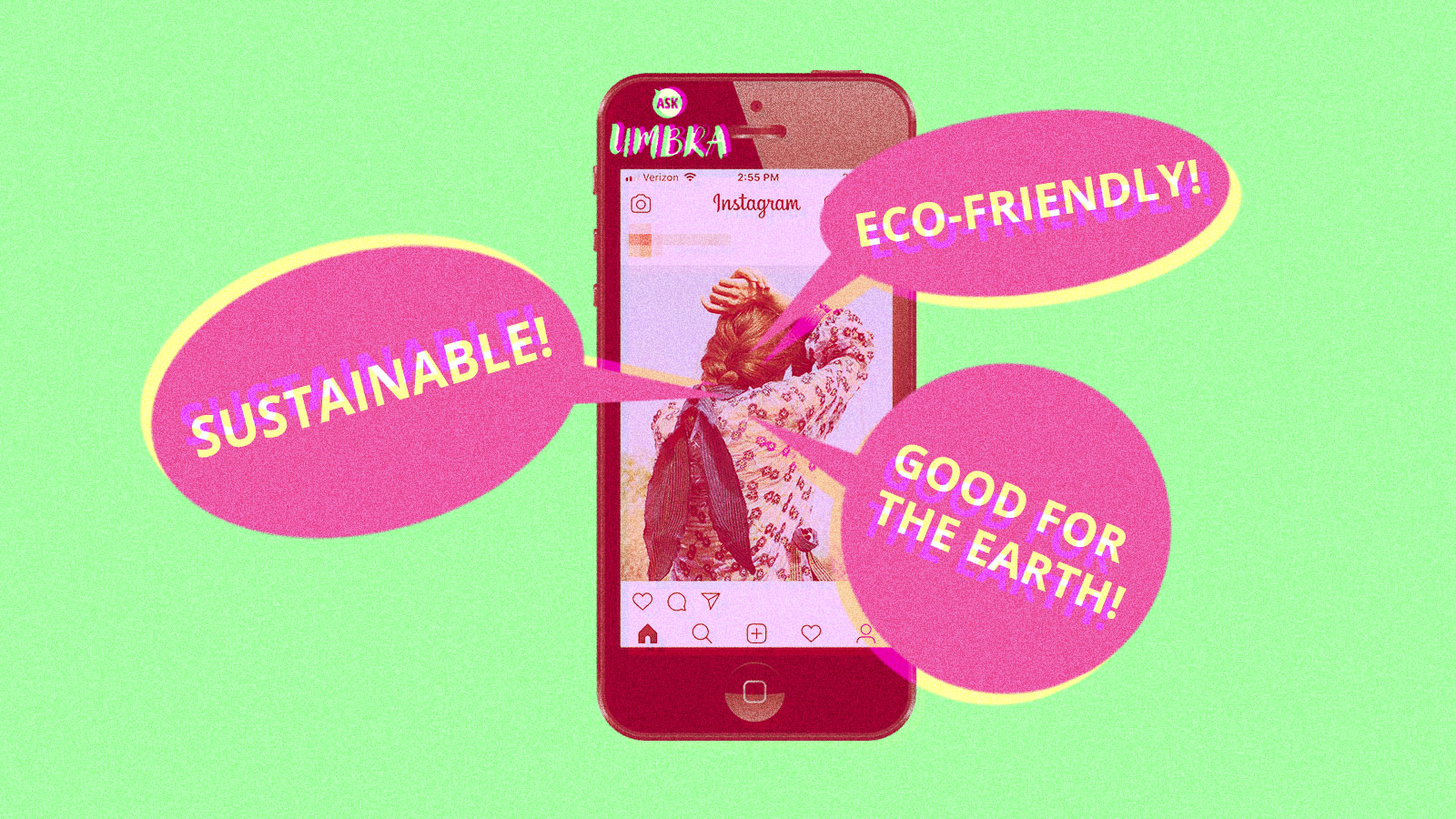Q. Dear Umbra,
I’ve been seeing a lot of ads for “environmentally friendly” or sustainable fashion brands that have cute designs, but it almost seems too good to be true. Is buying “eco-friendly” fashion actually good for the planet?
–Accountability vs. Greenwashing Hell
A. Dear AGH,
OK, good, it’s not just me. Your Instagram feed is apparently also approximately 75 percent “sustainable,” “eco-minded,” or “environmentally conscious” fashion ads. So many cute sports bras are out there saving the environment and splitting the dreaded uniboob! And they’re all 30 percent off on Earth Day! What an amazing world we have!
In the words of Cher Horowitz, whose wardrobe I would pillage if I ever had the chance, as if. On one hand, it’s true that the social and environmental impact of the apparel industry seems to be on a lot more people’s minds than it used to be. And the importance of that shouldn’t be understated. But for something as conceptually simple as clothing, 21st-century humans have developed a truly insane way of producing it.
You probably know this, AGH, or you wouldn’t be writing this question, but just for the people in the back: The carbon footprint of the apparel industry is an estimated 1.2 billion metric tons a year, but even that is a really big question mark for reasons we’re about to explain. That doesn’t even include the widespread contamination of water produced by manufacturing, the waste crisis induced by plentiful, cheap clothes, the labor abuses that take place in many sweatshops, or — this is a new, fun one — the fact that microfibers from plastic-based fabrics are now irretrievably scattered throughout our air and water.
So, you want to know if these brands that are ostensibly working to right the wrongs — or at least mitigate the damages — are legit. It’s a tough and surprisingly complex question because there are so many ways in which the apparel industry is harmful!
So let’s start with carbon footprint, because climate change is scary.
There’s no meaningful improvement without a starting point
“You’re talking to a person with a Ph.D. who has tried to compare the carbon footprints of various fabrics using data that is out there, and I’m here to tell you that that basic data is very scant,” said Linda Greer, a textile expert and toxicologist who spent over 20 years with the NRDC. She added that there’s no good reason for the lack of data, and that, in theory, it’s all readily measurable. It’s just that very, very few companies have actually undertaken that measurement so far, to her knowledge.
“A lot of these brands are starting to set science-based targets for carbon footprint, and they have another thing coming because they don’t even have a baseline for where their carbon footprint is right now,” she said.
In other words, it’s currently impossible to make fully informed carbon-minded purchasing decisions, because there’s not yet a way to get the comparative info on carbon footprints by fabric or item, since brands don’t have to account for the carbon emissions of their supply chains.
But that accountability could change with the right kind of legislation, Greer says. In China, for example, the country’s Ministry of Environmental Protection launched a massive inspection campaign in 2017 and found that 70 percent of the 14,000 businesses they examined were falling short of air pollution standards. The agency imposed big fines on violators in an attempt to “normalize compliance.”
So far, not only has the U.S. government not been interested in making companies measure their carbon footprints (which Greer says would have to include the embedded carbon of what they produce abroad in order to be meaningful), the Trump administration has actively dismantled several environmental regulations. But it’s possible a Green New Deal-type package, if passed, would address the apparel industry’s carbon emissions.
Beware of vague promises of “sustainability!!!”
Next up, “sustainability,” which has become an essentially meaningless term due to overuse, but we’ll use it to signify “commitment to prosocial and -environmental practices.” Sustainability is not entirely about greenhouse gases: It also requires being specific about how a product may contribute to environmental contaminants and impact the welfare of people who make it.
I talked with Gordon Renouf, co-founder of the app Good On You, which provides information about clothing brands’ environmental, social, or animal impacts for sustaina-curious clothing-shoppers. You should be wary of brands that describe their missions or processes with “airy-fairy language,” in his words, that evades any specific goals or policies.
“A brand that just says, ‘hey we’re great, we’re sustainable, we look out for our workers — that’s not telling you what you want to know,” Renouf said. “Where are the clothes made? Do they engage with unions? Are they audited? By whom, and how often? Do they use these chemicals? Do they ensure their factories are using good quality water practices?”
Consider a sock brand that touts the fact its products are made “from all-natural materials!” That usually means cotton, over 99 percent of which is conventionally farmed. Cotton is an infamously water-sucking and pesticide-heavy crop, so it’s actually not very good for the Earth. So, “all-natural materials” = meaningless. “Certified organic materials” means a bit more, because that’s at least adhering to a standard.
(Side note: There’s also an argument for plastic-based materials like polyester and nylon being good for the environment because they can be made from things like recycled bottles — maybe you’ve seen related ads from Adidas or Everlane. But now there’s the whole microfibers-flaking-off-into-the-water-system aspect of plastic fabrics, so you can easily see how weighing the environmental pros and cons of every material becomes a huge headache for someone who just wants to replace their leggings.)
Treat big brands like bad boys that are really hard to change
Adopting “show me the details!” as your new sustainability sniff test will serve you well, but don’t limit your assessment to a single product. Considering just how many fast fashion chains are jumping on the green bandwagon, it’s important to apply your sustainability sleuthing to the bigger brand as well. In 2013, fast fashion powerhouse H&M’s launched its “Conscious” collection, which claims organic and “sustainable” sourcing. Spanish mega-retailer Zara launched its Join Life collection in 2016, which offers clothing made from organic and recycled materials.
But these (usually comparatively small) segments of a big brand’s offerings don’t do much to compensate for their overall business model, which is to pump an astonishing amount of cheap, irresponsibly made, temporarily trendy clothing onto your closet floor. And that’s a debate that you have to decide for yourself: Do I want to support this brand at all, or do I want to signal to them as a customer that I’m only interested in their responsibly made offerings?
An example of a confirmable claim that might actually mean something: When clothing brands have lifelong repair or take-back-for-resale policies, like Patagonia or Eileen Fisher, respectively. That’s a practice that prolongs the life of the clothes they produce — which is huge because keeping good, functional clothing out of the trash needs to be a bigger priority for the apparel industry. (Zara, to give them credit, is now accepting old clothes to be recycled.)
The only guaranteed environmentally responsible choice is…
Fundamentally, the most environmentally-conscious clothes-shopping you can do isn’t necessarily about whom you buy from, but how long and how much you’ll wear what you buy. If you want to buy something new, apply the same rules that you would to a significant other: Don’t look for shininess, look for staying power! Yes, you should do some research on the brand’s ethics and environmental practices. You want to use whatever cash you might spend on clothes to put your consumer power behind producers who can back up their claims.
But you’ll also save yourself and the climate a lot of grief by limiting your new purchase search to items you’ll really love — any shoe purchase that requires homework, after all, is a shoe you must really, really want.
That’s not to say you can never impulse-buy things if you want them! I just recommend you do that at secondhand stores. The secondhand market eliminates much of that nightmare apparel industry guilt with the added bonus of cute and unique clothes at lower prices than retail. I’m a thrift store/Poshmark/Etsy vintage fanatic and I will probably sing all their praises until the end of time. Shopping and putting time and attention into dressing yourself can feel frivolous, but what the hell — we’re allowed to live and express ourselves even in the face of climate change!
My advice for the eco-aspirational wardrobe can be boiled down to two sentences (Sorry about the past thousand words, but it’s about the journey!): When you want to buy something new, research and invest. And when you want a fun post-mimosa afternoon activity, hit the consignment stores.
Thriftily,
Umbra
P.S. Here are some good resources for all that research you’re going to do!



